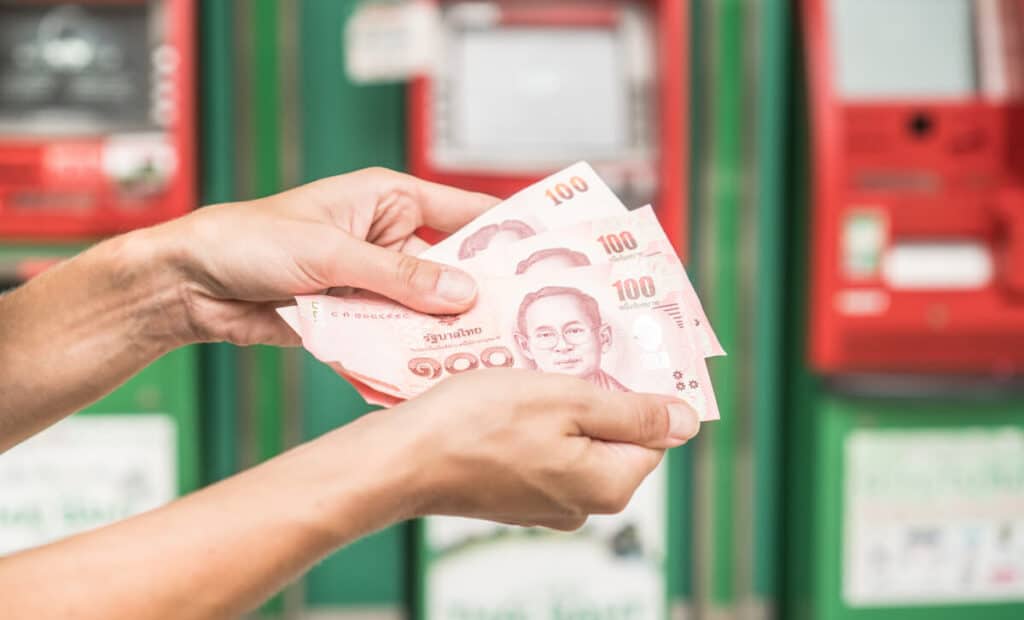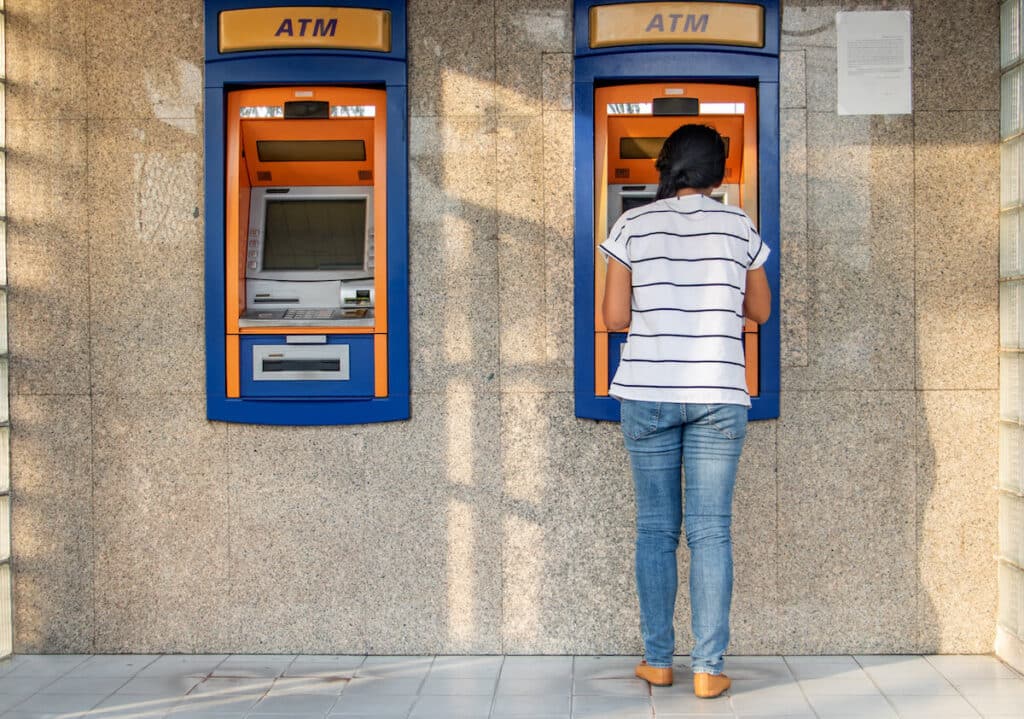Last updated on March 13th, 2024 at 09:25 am

Thailand, part of mainland Southeast Asia, is popular for its delicious cuisine, religious temples, beautiful beaches, and friendly people. Formerly referred to as Siam, and officially named the Kingdom of Thailand, it boasts a colorful currency called the Thai baht (THB). Continue reading to learn more about the Thailand currency.
Issued by The Bank of Thailand in Bangkok, THB’s one of the top 12 most frequently used currencies in the world[cm_simple_footnote id=1]. Before you convert THB into USD or vice versa, learn more about the currency, as well as how to find the best exchange rates when converting Thai currency to USD or sending money to Thailand via this Remitly guide.
Thailand currency basics
Like many currencies, Thailand’s currency is available in coins and banknotes. Paper banknotes come in denominations of 20 baht, 50 baht, 100 baht, 500 baht, and 1,000 baht, with 100 baht being the most commonly used.
The Thai central bank divides the baht into 100 satangs. Thai coins come in denominations of 1, 2, 5, 10, 25, and 50 satangs. The 10-satang coin is the most widely used.
The currency is most regularly referred to as Thai baht or simply baht, and the symbol for it is an uppercase B with a perpendicular line down the center (฿). You can identify the baht by its three-letter code, THB, on foreign currency exchange markets.
Facts about THB
Whether you need to send or exchange THB or just want to learn more about this Southeast Asian currency, review these facts:
It’s illegal to step on a baht
In the U.S., people may not handle bills and coins with much care. In Thailand, that’s certainly not the case. The country has a strict national law prohibiting insults to its monarchy, known as the lese-majeste law.
This law prohibits any verbal, physical, or written act that exhibits disrespectful behavior toward the king or any member of the royal family. Since all money in Thailand bears the portrait of the king or a deceased royal family member, this law extends to the handling of currency.
For instance, the following behaviors might be illegal in Thailand:
- Stepping on a coin
- Stepping on a banknote
- Burning, tearing, or writing on a banknote
However, many shops in Thailand display some smaller baht banknotes as a symbol of respect to the king.
It’s made of a special cotton
They make THB with a special cotton fiber designed to be extra durable. In fact, each banknote denomination has a different thickness and feel, so it’s easier to tell them apart when handling Thai currency.
The Bank of Thailand uses a process called intaglio printing that leaves the print slightly raised, which allows for a very tactile feel compared to other currencies.
You can often find the denominations displayed in Arabic numerals and Thai numerals. You can also find hidden Arabic numerals on the lower-left corner of each banknote.
Each banknote features a king
King Maha Vajiralongkorn, Thailand’s current king, has his face on the 20-, 50-, and 100-baht banknotes. King Maha Vajiralongkorn’s face is on the most recent editions of the 500- and 1,000-baht banknotes, which were issued on his birthday in 2018. The primary colors and sizes of the notes are the same as before, with the back designs featuring images of the kings of Thailand in order from past to present.

History of Thailand currency
Thailand’s money wasn’t always in paper form. Before developing modern banknotes, Thailand used shells—pot duang—and baked clay coins as legal tender.
During the reign of King Mongkut in the 19th century, Thailand introduced free trade and established diplomatic relations with Western countries. Imports and exports increased significantly, and as a result, there wasn’t enough pot duang to meet the demand.
In 1853, to combat the demand for more currency, King Mongkut ordered the first paper money, called “Mai.” However, It wasn’t very successful because people still preferred to use the pot duang instead of the official currency.
Since then, Thailand’s faced serious currency shortages several times. When King Chulalongkorn arrived in 1873, copper coins of low value were incredibly scarce. The value of tin and copper in the world market rose above the face value of the coins.
At that point, people started using the “pee,” a type of currency they could exchange for money at the casinos. King Chulalongkorn wanted to avoid its use, so he introduced a low-value paper currency called “Att Kradat,” while waiting for copper coins that were supposed to come from England. Leaders would withdraw these from circulation in 1875.
Because there still weren’t enough Thai coins in circulation to meet the demand, the government allowed three foreign commercial banks to operate and issue banknotes in 1889, 1898, and 1899.
For more about Thai culture, check out this guide to their famous Songkran festival.
Understanding THB exchange rates
The baht is the only legal tender in Thailand, so if you travel there, you’ll need your money exchanged into baht. Likewise, if you send money to Thailand, make sure it’s in baht, not in U.S. dollars (USD), British pounds (GBP), or euros (EUR).
The best time to exchange Thai baht depends on the currency exchange rate for each currency pair, which fluctuates.
If you’re converting between dollars and Thai baht, then you’ll want to look at the USD rate. As of Dec. 30, 2023, 1 USD was equal to 34.25 THB.
You’ll get a different rate if you’re converting Canadian dollars (CAD), Australian dollars (AUD), or New Zealand dollars (NZD).
Here are a few other currency pairs and the amount that 1 Thai baht is equivalent to using the exchange rate on Dec. 30, 2023:
- 1 THB = 0.024 Swiss franc (CHF)
- 1 THB = 2.39 Indian rupee (INR)
- 1 THB = 4.05 Japanese yen (JPY)
- 1 THB = 0.14 Brazilian real (BRL)
- 1 THB = 25.40 Chilean peso (CLP)
- 1 THB = 0.20 Chinese yuan (CNY)
- 1 THB = 0.89 Egyptian pound (EGP)
- 1 THB = 0.22 Hong Kong dollar (HKD)
- 1 THB = 441.88 Indonesian rupiah (IDR)
- 1 THB = 0.49 Mexican peso (MXN)
- 1 THB = 0.13 Malaysian ringgit (MYR)
- 1 THB = 8.00 Pakistani rupee (PKR)
- 1 THB = 0.11 Polish złoty (PLN)
- 1 THB = 0.29 Swedish krona (SEK)
Of course, exchange rates fluctuate all the time, so these are just a snapshot of each currency conversion.
Always check the latest exchange rate for Thai currency to USD—or another currency pair—before initiating an international money transfer.
For more on understanding exchange rates, consult an exchange rate guide. You can also check with your bank or your favorite money transfer company for current Thai baht exchange rates.
For example, when you use the Remitly app and choose Thailand as your destination, you can see the current rates for USD to baht, GBP to baht, and more.
Sending money to Thailand

Thailand’s currency has gone through many changes over the years, but it’s one of the most frequently traded currencies in the world.
If you need to send money to family and friends in Thailand, it’s safest to use a money transfer service—especially if you’re sending sizeable sums of money at once.
